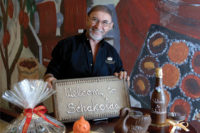

Alex Paukin, who heads up the quality assurance department at the company, performs a variety of tests (top to bottom) on cocoa beans and cocoa liquor, including a viscosity analysis, a fineness measurement, and a cutting test of cocoa beans.
"He who tastes, knows." -Ancient Sufi proverb
One of Gary Guittard’s favorite memories as a child was going into the plant and tasting the cocoa liquor as it was undergoing the refining process. Fifty-plus years later, Guittard, president of Burlingame, Calif.-based Guittard Chocolate Co. and the recipient of Candy Industry’s 63rd Kettle Award, continues to taste cocoa liquor.He and close colleague/friend, Ed Seguine, v.p. of research and development at the company, probably go through thousands of cocoa liquor sample cups during the course of a year. And while Guittard may not have that same sense of wide-eyed wonder he did as a 10-year-old, the aim – aside from enjoying theobroma – remains remarkably the same: finding the best-tasting chocolate.
“I loved tasting chocolate as a kid,” he says. “I also loved comparing our chocolate with the best chocolate in the world. At the time, I didn’t feel we were as good as other European chocolates.”
Today, Guittard holds a different opinion about the namesake chocolate produced at the plant.
“I feel real comfortable about what we’re making; I’d say we’re in the top 1-2% tier of chocolate producers in the world. And when it comes to having the broadest range of styles under one roof, we’re probably the best. We offer a deep, dark Belgium style of chocolate as well as a piquey, aromatic, fruity French style.”
Few people in the United States – excepting Seguine – have the ability to truly taste chocolate’s essence like Guittard does. Nevertheless, most Kettle Award recipients aren’t recognized for their palate. Rather, it’s a combination of corporate and industry leadership that leads to the honor.
Guittard, through a combination of circumstance and conviction, has demonstrated such leadership qualities. First, when the role of president was thrust upon him in 1989 following the successive deaths of his father, Horace, and brother, Jay, within a six-month period, Gary found himself responsible for perpetuating a legacy that went back to 1868.
“The three of us all sat in one office,” he recalls. “We were really close to each other.
“But we have great people working here; they picked up the challenge. It was real team effort.”
Gerald Allen, Guittard Chocolate Co.’s vice president of operations, echoes those sentiments.
“We all felt a huge commitment to Gary,” he says. “We gathered around Gary to support him. As it turned out, the experience proved to be akin to a rose bud blossoming. The challenge of running the company helped Gary open up.”
One of the early challenges the then 44-year-old executive faced involved a grass-roots evolution of American taste buds. Beginning with wine and then spreading out toward coffee, cheese and bread, consumers were gradually discovering the delights of premium products offering more intense flavors and aromas as well as specific origins.
It was during this evolution that two industry unknowns, John Scharffenberger and Robert Steinberg teamed up to create a bean-to-bar chocolate company (Scharffen Berger Master Chocolate) producing a high-end premium dark chocolate bar.
The semi-retired vintner (Scharffenberger) and physician (Steinberg) quickly became media darlings in Gary’s backyard (San Francisco), winning over foodies with their message about exotic cacao bean origins and old-fashioned processing methods.
In the background stood Guittard Chocolate Co., a fourth-generation chocolate maker that had a history of sourcing beans from every corner of the globe. Nevertheless, in addressing the needs of the marketplace during the 1980s and early 1990s, the company had focused on supplying mainstream chocolates.
Seguine recalls the moment when Gary, aware of the publicity that the Scharffen Berger Master Chocolate company was generating, decided to return Guittard Chocolate to its roots.
“One of our employees was cleaning out our safe, essentially a holding place that was a replica of Fibber McGee and Molly’s closet,” Seguine says. [Editor’s note: Fibber McGee and Molly, a classic old-time radio program that regularly had its hosts open up a closet full of junk.] “In doing so, he found some old books and binders, some of which went back to founder and great-grandfather Etienne Guittard’s time.
“So here were Gary and I sitting in his office, looking through these binders that held recipes. We even found one for a raspberry syrup. They were written in this absolutely beautifully elegant ink script. It was the kind of penmanship that you associate with a different time, a different day. Back then, you weren’t worried about how fast you can get your conch to cycle.
“We looked at old chocolate recipes that had the names of beans that we hadn’t seen in years: Maracaibo, Puerto Cabello, Java, Samoa and Accra, the old name used for Ghana beans.
“These were the beans that Gary’s great-grandfather and grandfather were working with. So there we were, the two of us saying that we need to do this, that we need to bring this heritage back in-house.”
Seguine then smiles wryly and adds, “Of course, that means you spend the rest of your life tasting cocoa liquor.”
The decision to restore that part of Guittard’s heritage involving premium and exotic beans didn’t, however, result in an overnight transformation.
“It took us about five to seven years,” Gary says. “But it was a matter of getting it right, working with farmers, getting them to improve post-harvest practices, and then learning how to process the beans. The key was to maintain the flavor and not wreck it.”
In the interim, press reports surfaced about forced child labor practices in West Africa. Gary, who just happened to take over as chairman of the Chocolate Manufacturers Association (CMA) in early 2001, now faced one of the industry’s most intense media investigations.
Amidst cameras and microphones, Gary calmly assured the media and public that the industry would fully investigate the allegations and then marshal its forces to take action. Given the complexity involved when dealing with foreign and local governments, brokers, farmers, varied U.S. agencies, not to mention manufacturers and suppliers, the CMA – with Gary at the forefront -- painstakingly helped broker an international protocol involving all parties. The protocol sought first to define the scope of the problem and then eradicate it.
Since its debut in Oct. 2001, the Harkin-Engel Protocol (named after U.S. Congressmen Tom Harkin and Eliot Engel who became intimately involved in the issue), has made considerable progress.
Although the congressmen’s most recent trip (early January 2008) to the Ivory Coast and Ghana reaffirmed the effort made by the global cocoa community, the two politicians indicated that still more has to be done.
Gary, while agreeing with the two politicians, strongly stresses the need to recognize the accomplishments to date.
“This mobilizing of industry has been a huge positive for West Africa,” he says. “It’s laying the foundation and creating an infrastructure that will penetrate all parts of society. What’s been accomplished is just awesome. Hershey and Mars have done a great job in working with the Harkin-Engel Protocol. The industry believes it’s very important to do this and the response shows we mean it.”
Fast forward a few more years and once again Gary found himself in a maelstrom of controversy involving chocolate. This time, it involved a proposed change initiated by the Grocery Manufacturers Association in 2007 to “modernize” the Food & Drug Administration’s standards of identity in various food products, one of them being chocolate.

Gerry Allen, v.p.-operations explains the inner workings of a newly purchased Lehmann triple stone mill. An older Lehmann triple stone mill (right) grinds the nibs into cocoa liquor.
In an attempt to update the standard, the proposed revision would allow the use of fats other than cocoa butter as well as allow the replacement of milk solids with whey in the production of milk chocolate. In the European Union, manufacturers are allowed to add 5% of another fat and still call the item chocolate.
To Gary, the move to permit vegetable fats in creating chocolate represented a calculated move to trim costs and lower the “gold standard” of quality. Oddly enough, the move was supported by the CMA.
“In the beginning, I tried to let people know about this pending change – and my reasons against it – anonymously,” he explains. It didn’t take long, however, before Gary found himself spearheading an industry and consumer movement against any tampering of chocolate’s gold standard.
The media, almost as voraciously as with the forced child labor issue, sought out Gary for his comments on the petition to the FDA. Gary, in turn, created a “Don’t mess with my chocolate” Web site that informed consumers about the issues at stake and encouraged them to send their comments to the FDA.
“I felt real strongly about this issue, particularly since I don’t believe it was given a proper review by our industry,” he says. “We needed an industrywide dialogue on the subject and there wasn’t any. I had to do something.”
It didn’t take long before the public chimed in, flooding the FDA with comments against the proposed change.
“There were more comments [38,000-plus] to the FDA on this one subject than there were in the entire history of nutrition labeling,” Seguine says. Although the petition is still working its way through the FDA bureaucratic process, it’s fairly certain chocolate will not be touched.
That doesn’t mean Gary doesn’t want to modernize the standard of identity, however.
“I’d like to see changes that would clarify some points, like adding percentages to define semi-sweet and bittersweet. And we should allow sugar-free chocolate to be called chocolate. Right now, the use of non-nutritive sweeteners preclude sugar-free chocolate from being called chocolate.”
These clarifications would help the public as well, Gary adds. Currently, consumers often think that cocoa content determines whether a piece of chocolate is good or not. And yet, most consumers – and even some confectioners – don’t understand that cocoa content reflects the combination of cocoa liquor and cocoa butter. A chocolate containing 65% cocoa content could be as good or better than one containing 70% or 75%. It depends on the beans, the processing, he says.
Regardless of the percentages, the good news stemming from research into chocolate’s high level of antioxidants by a host of industry and non-industry groups has stimulated an appetite for dark and premium chocolates.
Gary, while admitting that this boon in chocolate bodes well for a company such as Guittard, points out that it’s critical to remain efficient as well as innovative.
To that end, the company invested several million dollars in 2003 to construct a 300,000-sq.-ft. facility in Fairfield, Calif. The plant represents a long-term strategy, one that initially emphasized on taking advantage of a new distribution and warehousing point to where it’s now poised to become the company’s primary production center.
Having recently installed a Concetti Group bagmaker and Pearson Packaging System bag-in-box line earlier this year, the company now handles most of its bulk packaging needs in Fairfield. Plans call for depositing operations to be in place by the end of 2009.
And while Gary envisions that most of the company’s production process – with the exception of cocoa bean sorting, winnowing and roasting – will take place in Fairfield, he’s in no hurry to accelerate the process.
As a relatively small player (2007 sales estimated between $25-50 million) in chocolate processing and manufacture, with wholesale revenues comprising the bulk (85%) of company sales (retail product sales make up the remainder), Guittard Chocolate remains cautious in balancing investment costs alongside sales growth. It’s a “grow as you go” philosophy.
Still, the going has picked up in pace, thanks to the dark and premium chocolate growth phenomenon.
Mark Spini, director of industrial sales and marketing, acknowledges that the recent surge in dark and premium chocolate sales has kept the company’s annual growth gains “on the plus size.”
At the same time, he attributes Guittard Chocolate’s ability to capitalize on this trend to Gary, who spearheaded the company’s efforts to be one of the first in the United States to offer single-origin chocolates.
“It was due to his passion for chocolate and for fine flavors,” he says. “We were the first chocolate company to exhibit in the Fancy Food show. We’re also a sponsor of the World Pastry Competition and are involved with the International Association of Culinary Professionals.”
Such positioning has proven timely with the artisanal chocolatier renaissance springing up throughout the United States, Spini says.
Moreover, it’s no secret that Guittard Chocolate has worked with and cultivated the tastes of America’s top pastry chefs.
Donald Wressel, the head pastry chef at the Four Seasons Los Angeles, and past manager and coach for several U.S. World Cup Pastry teams (he led the U.S. team to a gold in 2001 and a bronze in 2005), represents Guittard Chocolate at various culinary events.
That association has helped the company garner feedback from “high-end palates” and explore flavor profiles well beyond that of a mainstream chocolate supplier. Naturally, Gary and Seguine are leading that discovery.
One of the company’s newest product lines, dubbed Complexity, has already been exceptionally well-received by the culinary community. The chocolate represents a blend of nine different single-origin beans.
As Seguine explains, “We’ve taken fine flavor cocoas with distinct properties and characteristics and blended them to have a broader utility. Thus, we have a chocolate that’s fruity, flavorful, brighter and deeper than any one origin, but can be used more extensively. It achieves a gestalt fine balance between extreme uniqueness and breadth.”
Word on the street is that chefs can’t wait to get their hands on the chocolate. Due to go into mass production soon, Gary and Seguine are overseeing the final “tweaking.”
Referring to Complexity, Gary admits to having created “some real intriguing, complex flavor experiences.”
That’s not the end of new launches, however. By next year, the company expects to have a line of organic chocolates available.
“We’re in the process of getting ourselves certified,” he says. The issue, however, is “finding good organic beans.”
Knowing Gary, that too will be resolved, but not before the organic cocoa beans pass his and Seguine’s cocoa liquor taste test. In the end, Etienne wouldn’t have it any other way.





